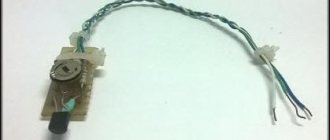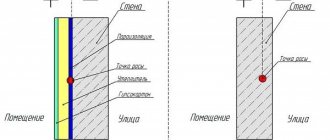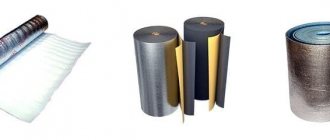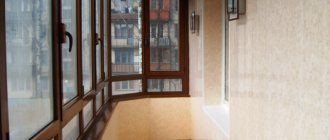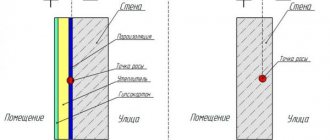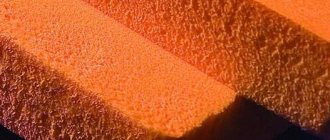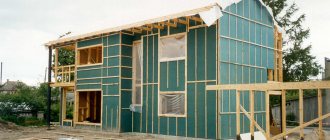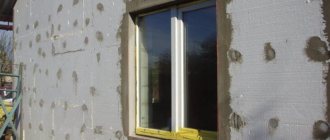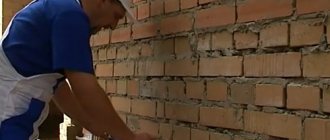The rapidity of progress affects all areas of life, but it is especially noticeable in the construction market. Here, not even a month goes by without innovation. Innovations have significantly changed and simplified the technological processes of all stages of construction, making life easier for both professionals and beginners. Thanks to the use of advanced technologies, labor-intensive processes in the construction, reconstruction and repair of buildings, such as brickwork or concrete flooring, are being replaced by new, simpler ones. An excellent way to install a high-quality and quick floor covering is to make a dry screed from gypsum fiber board sheets. The work is carried out in comfortable conditions, without dirt and dust, with minimal labor costs.
GVL sheets
GVL - getting acquainted with the material
Conventional plasterboard on large construction sites and during local repair work is increasingly being replaced by a new generation of sheet material - GVL (gypsum fiber sheet). It consists of polished slabs made of ordinary gypsum, but reinforced with reinforcement. For this purpose, fluff pulp is used - a product of waste paper processing. During the manufacturing process, boards marked GVLV are impregnated with hydrophobic compounds. A feature of gypsum fiber sheets that distinguishes them favorably from plasterboard is the absence of a cardboard shell, uniformity of structure, which gives the material high strength characteristics. The technology, in its principle, is very similar to Knauf dry screed.
Preparatory stage of work
Before starting work on the screed, it is necessary to dismantle the old existing floor covering - it can be parquet, wooden flooring, old tiles. If this is an overlap, it is necessary to repair large dents and holes with mortar or putty. After the solution has dried, it is necessary to vacuum the floor surface, remove all construction debris, and in some cases it is necessary to prime the surface. By this time, all materials must be purchased and delivered to the site. After this, you can begin installing a vapor barrier.
Gypsum fiber for floors: pros and cons
Gypsum fiber sheets are used for covering any surfaces in apartments, private houses, and public buildings. Using GVL, you can quickly and conveniently finish walls and ceilings. They are much better suited for installing subfloors under flooring than plasterboard or fiberboard. Plasterboard boards with moisture-resistant properties declared by the manufacturer, when water gets on their surface, quickly collapse and warp. In addition, gypsum plasterboard is quite fragile; with strong targeted impacts, it can split.
Gypsum fiber boards behave completely differently under similar conditions. They differ:
- fire resistance - gypsum does not burn, the maximum damage that fire can cause to it is charring of the surface;
- strength - reinforcement gives brittle gypsum hardness sufficient for the use of gypsum plasterboard as a floor covering;
- moisture resistance - water does not penetrate into the pores of GVLV (moisture-resistant) boards due to treatment with water-repellent impregnation;
- low thermal conductivity - this indicator makes GV sheets an ideal material for laying on the floor; they act as insulation;
- resistance to low temperatures - unlike drywall, which can withstand only four cycles of freezing and defrosting, GVL can withstand as many as 15 such cycles.
A small fly in the ointment in a huge barrel of honey - the cost of the material is quite high compared to drywall, however, it is justified by its advantages.
Installation errors
When installing gypsum fiber board floors, it is necessary to strictly follow the sequence of work and installation rules in order to avoid possible defects:
- pushing through the floor if you did not cut off the folded edge of the gypsum fiber sheets near the walls;
- uneven subsidence of the floor due to shrinkage of expanded clay if the beacons have not been removed;
- deformation of gypsum plasterboard, in case of laying on wet expanded clay, failure to make technological gaps between the sheets and in places adjacent to the walls.
By following our recommendations and observing the technology, you will be able to install the GVL base yourself or supervise the work of contractors. As a result, you get a durable, strong, perfectly flat base for any floor finish.
Selecting high-quality gypsum fiber sheets for flooring
Sheet sizes
How to choose the right GVL for a specific room? First of all, pay attention to the price and manufacturer. Well-known companies maintain their brand and do not release obviously low-quality products. Low cost signals low quality due to the use of low-quality components or defects in the production process. By trying to save on material, you can lose much more time and money later when defective slabs fail before their stated service life.
When installing floors in rooms with high humidity - kitchens, bathrooms, baths, saunas, choose special moisture-resistant GVLV slabs. For other rooms, ordinary gypsum fiber sheets are sufficient. Between single-layer gypsum fiber boards of standard or small format sizes and sheets consisting of two layers, the latter are often chosen for flooring. They are made of two plates glued together offset and forming a locking system. This material is especially easy to install. It is from this that the so-called “dry” screed is usually made.
Installation features: how and how to cut gypsum plasterboard at home
It is permissible to lay gypsum fiber boards on both a continuous and discontinuous base. It is necessary that it be perfectly flat and not have differences of more than 2 mm for every 2 m of length. This is due to the fact that the sheet can bend and repeat the shape of the recess, which will affect the evenness of the surface.
The base should be laid especially carefully if you plan to lay parquet, parquet boards or other wooden covering on top, which may diverge a little and creak. If the unevenness remains under the linoleum, a violation of the integrity in this place is quite possible, especially when furniture is installed on top.
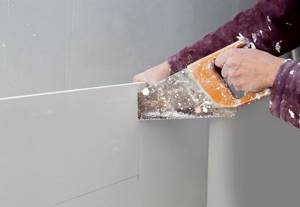
For cutting gypsum fiber boards, saws, grinders and metal knives are used.
Another point concerns the laying of gypsum fiber boards on a loose base or wooden logs. In this case, it is better to use moisture-resistant GVL for the floor - moisture-resistant Knauf marked “EP” is considered the best option. It is better to lay 2 layers at once and at the same time make sure that the sheets are shifted relative to each other and the seams do not coincide.
When laying on a movable base, including joists, it is better to use an elastic filler for joints, for example, silicone sealant, which remains elastic even after drying.
How to cut GVL Knauf floor elements or other types of material? The fastest result can be achieved by using an angle grinder, but you need to take into account that the process will be accompanied by the formation of dust.
You can also use a regular metal knife for cutting. Of course, the process will take a little longer, because you will have to run it along the base at least 6-8 times so that a deep groove remains, and then try to break the sheet. At the same time, many focus on the fact that it is necessary to break the slab with an upward, rather than downward, movement.
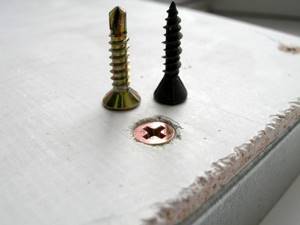
For installation of gypsum fiber sheets, it is recommended to use special screws
Manufacturers recommend installing sheets using special self-tapping screws marked “for gypsum fiber.” The main difference from conventional fasteners is the presence of a head with a sharper cone, which allows the fastener to penetrate deep into the sheet without pre-drilling. The length of the screw should be 3 times the thickness of the plate used.
Advantages of dry screed
Although concrete coating is one of the most reliable, any craftsman, having once laid a floor from gypsum fiber sheets, is unlikely to want to tinker with concrete mortar for constructing a monolith the next time. Moreover, gypsum fiber has high hardness and is perfect for laying subfloors. They do not bend or creak and are suitable for laying any floor covering.
Installing gypsum fiber sheets is a real pleasure, especially for professional builders. Amateurs getting down to business for the first time can also easily cope with this dust-free work.
The material is easy to cut and, thanks to its low weight, is easy to install. Under the floors made using the dry method, utilities are placed and cable mats are laid for the installation of a “warm floor” system.
Dry screed base
The basis for laying GVL sheets is both a concrete coating and a wooden floor. Before starting installation, standard base preparation is required:
- concrete screed - the surface is leveled, cracks are filled with mortar, and if necessary, rough grinding is performed;
- lean concrete is a cheaper base option;
- wooden floor - repair of failed joists is carried out, the gaps between the floorboards are sealed with special putty.
When installing floors, special attention is paid to the horizontal surface. At all stages of work, from leveling the base to installing the finished floor, control is carried out using a building level or level.
In what cases is it appropriate to use gypsum fiber boards?
Decorating the floor with gypsum fiber boards is appropriate for creating a screed in any room. First of all, this will help reduce the pressure on the floors. For comparison, you can take a self-leveling floor. Firstly, you will have to purchase a large number of materials, such as cement, gravel and sand. Secondly, you need to wait a few days before starting installation of the finishing coating. Thirdly, the weight of the screed will be at least 100-150 kg per m², which is especially important if we are not talking about the first floor. We should not forget that to complete all the steps you will probably need a concrete mixer, which is not so easy to carry to the upper floors.
Based on the listed facts, it becomes clear that gypsum fiber is an excellent alternative to self-leveling flooring, which allows you to avoid such difficulties and speed up construction and repair work. In addition, it is appropriate to use gypsum fiber board for flooring under tiles and other flooring options.
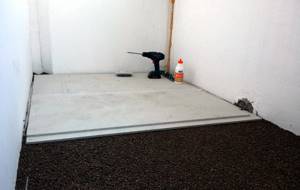
Gypsum fiber sheets can be used not only for leveling the floor, but also for insulation
Helpful advice! For a warm water floor, GVL is not an obstacle. The sheets fit well on top of the system, you just need to be careful not to damage the communications during installation.
If additional insulation of the surface is required, fibrous polystyrene foam or fill-in-fill insulators are used. Most often, expanded clay is used for this, which has good characteristics and low cost.
Popular questions:
Which expanded clay is better for the floor, which fraction to choose? There is an answer from an expert
Which floor is better, concrete or wood? There is an answer from an expert
Which floor is better to make in the garage, which option is cheaper There is an answer from an expert
All questions
Laying technique
To align the GVL accurately enough, you must follow the following steps:
- A waterproofing base material is laid on the finished base. For concrete screed, a polyethylene film 0.2 mm thick is suitable. For wooden bases, glassine is used. It is better to place the edges of the waterproofing towards the wall, and seal the joints with waterproofing tape.
- The perimeter of the walls is covered with edge tape. It helps prevent cracking and deformation of gypsum fiber boards.
- The surface is covered over the entire base with amorphous insulation to a thickness of 2 cm or more, leveled according to the rule.
- The first layer of slabs begins to be installed from the wall furthest from the door. The folds are treated with PVA glue, and for reliability the material itself is fastened with self-tapping screws in increments of 30 cm, depending on the size of the sheets.
- The entire surface is lubricated with glue, then a new sheet of gypsum fiber board is laid.
- The resulting joints between the plates are sealed with putty. Marks from self-tapping screws are especially carefully sealed.
After these manipulations, they begin laying the finished floor.
Suitable:
- tile;
- parquet;
- boards;
- laminate;
- PVC tiles;
- linoleum.


